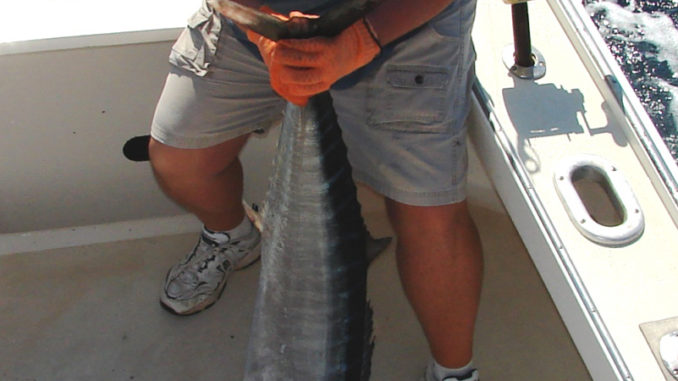
There is not an abundance of information on wahoo, acanthocybium solanderi. They are primarily fish of the Gulf Stream and its eddies, but occasionally wander closer to shore when the waters warm in late summer and early fall.
Wahoo are an offshore, warm-water fish usually found alone or in small groups. They congregate near temperature breaks, eddying currents and drifting objects like sargassum weed. While found throughout warm oceans and seas worldwide, in the western Atlantic, they range from New Jersey to Colombia. They migrate northward each spring with the warm waters of the Gulf Stream and most return southward for the winter. There are some wahoo along the Gulf Stream temperature breaks off the Carolinas all year.
Wahoo have long, narrow bodies, with long snouts and long dorsal fins. The body is steel blue on top and pale blue on the bottom, and the colors are very bright when first landed but fade quickly in a fish box. Wahoo have 25 to 30 blackish-blue vertical bands that extend down the side to below the lateral line.Wahoo have no gill rakers and are most commonly confused with king mackerel.
Wahoo can grow to six feet and can exceed 100 pounds in weight. The N.C. Division of Marine Fisheries awards ciations for wahoo weighing 40 pounds or more. The state record is 150 pounds and was caught off Ocracoke in 1994.
Wahoo in the 80-pound range are . surprisingly common at times. Wahoo have a lighter meat than mackerel and is revered by those who appreciate fish. They are also one of the open ocean pelagic fish that don’t develop a “strong” taste as they get large.
Wahoo are an open ocean predator and feed primarily on other fish. Frigate mackerel, butterfish, porcupine fish, round herring, sardines, cigar minnows and squid are regularly found as stomach contents on fish caught and cleaned. They are aggressive when feeding and sometimes grasp and swallow their quarry whole. Wahoo have been cleaned that were still feeding even with previously bitten off lures in their throats and stomachs.
Like dolphin, wahoo are short-lived and grow rapidly. Most reach sexual maturity in their first year. Spawning along the southeastern United States occurs during June, July and August.
The primary techniques for catching wahoo are trolling brightly-colored lures at high speeds along Gulf Stream temperature breaks and trolling rigged ballyhoo and squid behind plastic and hair skirts. The lures are generally trolled faster (up to 15 knots) than the rigged natural baits (four to seven knots).
Wahoo have many very sharp teeth, and wire leaders are preferred to prevent bite-offs. A few are caught closer in each year by king mackerel fishermen using live baits.


Be the first to comment